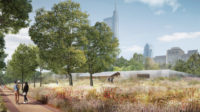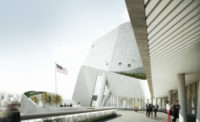The blueprint, invented in the 1840s, was ubiquitous in architecture offices—to which it lent a slightly acrid smell—for much of the 20th century. Now the medium confers a certain authenticity, a kind of Instragram-ish patina, says architect Florian Idenburg, though, he notes that paradoxically, a blueprint is also a plan for the future.
Building on that paradox, Idenburg and Jing Liu (his partner in the architecture firm SO–IL Solid Objectives) and artist Sebastiaan Bremer have created BLUEPRINT, a show for the Storefront for Art and Architecture (through March 21) in which 50 images are exhibited in blueprint form. (Many of the pieces were in earlier versions of the show, including one at MOCA Tucson.) Artists and architects (the latter group selected by Idenburg and Liu) were asked to look back and identify one “fundamental” work: the first piece that could serve as a blueprint for their later careers. Submitted digitally, the images were converted into blueprints by SoHo Reprographics.
Some of the submissions are purely architectural, like Jesse Reiser and Nanako Umemoto’s Cardiff Bay Opera House competition drawing (1994). Others are architectural riffs: Vito Acconci contributed his design for an exploding house (1981) and Julian LaVerdiere, his drawing of a Tower of Babel connected to a space elevator, from 1999 (LaVerdiere jokes, in the exhibition program, that “it all made perfect sense to me then”). Vik Muniz provided a 1993 photograph of lumps of cotton arranged like a particularly anthropomorphic cloud, foreshadowing his later work with refuse.
The pieces are mounted on the long back wall of Storefront’s triangular space. Outside, Liu and Idenburg had the famous Steven Holl-Vito Acconci facade shrink-wrapped in white plastic, specifically, 12-millimeter-thick flame-retardant polyethylene, donated by a supplier called Dr. Shrink. (The architects have often used wrappers and scrims, as at their Kukje Gallery in Seoul and Logan offices in Manhattan.) In this case, daylight shines through the translucent material as if to “expose” the blueprints inside. Outside, the white surface proved irresistible to graffiti artists, who tagged it soon after the opening. Storefront is experimenting with ways of hiding the graffiti. It’s too bad the spray-painters didn’t use blue.









